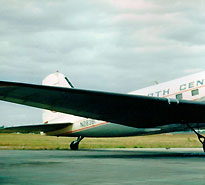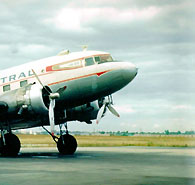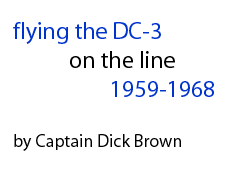 |
 |

More than once I have been asked, “What was the DC-3 like as an aircraft and what was it like to fly?” To be sure, this twelve and a half ton piece of Douglas workmanship could be a hand full, especially in stiff cross wind conditions that would tax the best of a pilot’s skill.
The first flight of the DC-3 took place on December 17, 1935 at Santa Monica, California. North Central took delivery of its first six DC-3s in October 1950. They came from many sources such as Delta, Eastern and we even had two from the U.S. Navy. At 32 in number, NCA had the distinction of being the largest fleet operator of the type in the world. Those aircraft remained in service with NCA until the mid 1970s. The DC-3 was the aircraft that finally brought profits to the airlines in the late 1930s without being supplemented by mail pay. Following WWII it brought real air travel to many small towns across this nation as provided by the trunk airlines. Additionally, in the late 1940s a system of local service airlines began to serve the smaller communities as the train and bus routes began to fade away. The DC-3 was reliable; it could deal with the most severe winter flying conditions that included moderate to severe icing…..if properly “managed”.
The power plants used on this aircraft were either the Pratt & Whitney R-1830 or the Wright R-1820. The P&W was used on most military versions (C-47) and many of the airlines also opted for it. North Central preferred the Wright R-1820-G202A. As a newly hired F/O, I inquired as to why and was advised that the 1830 had a two stage blower on it for higher altitude operations. Since NCA’s airports were mostly all at or below 1,500 feet and the terrain was pretty level, the need for higher altitude operation was not a requirement and besides, the 1820, being a single row radial engine, was easier to work on and thus more economical to maintain.
The noise levels in the cockpit were not that bad. During takeoff you could still make yourself heard in an emergency and in cruise, normal conversation was possible. The temperature comfort level in the cockpit was pretty good….in spring and fall. In summer we made use of the ram air duct that brought in air from the out side and we often flew with the side windows open while in cruise. On the ground it was another story as we had only the side windows for ventilation. Now winter time was a real challenge. NCA did have a very good Janitrol Surface Combustion Heater that made the cabin reasonably comfortable in the air as well as on the ground, but the cockpit, being located at the very front of the aircraft, did require a bit more “ingenuity” on the part of the pilots in order to keep warm. We simply brought one of the cabin blankets up front and draped it across the bulkhead opening between the two pilot seats. It would cover the lower 5 feet of the opening and thus allow the stewardess to pass our paper work and coffee over the top without difficulty. We also wore a sweater over our uniform shirts on really cold weather occasions. Now dealing with rain was another challenge as the cockpit leaked like a sieve. Behind each pilot seat was a canvas pouch that held a heavy gauge plastic apron. Just draping the apron over your lap was enough to stave off getting drenched in the event of a passing rain shower. But let me also say something more about our DC-3 cockpits. If you saw one, you saw them all…..they were the most standardized cockpits in the industry, as were the passenger cabins, and that was something to be very proud of.
The aircraft systems were quite simple on the DC-3. All controls were connected directly to their components via mechanical means in the cockpit. The more modern airliners that followed the DC-3 used a cockpit switch to actuate the physical control at a more distant point in the airplane’s structure. Example: The fuel system: The tank control selector valves were on either side of the center pedestal and were connected to the actual fuel valve by a mechanical linkage. The hydraulic controls for actuating the cowl flaps, wing flaps, landing gear and windshield wipers were all right in the cockpit. The control for the de-icer boots was located on the bulkhead behind the First Officer’s seat and was directly connected to the distributor valve by cable. About the only control that might have been considered remote was the prop governor control which consisted of a flexible cable control that ran between the two prop levers on the center pedestal to the prop governor that was mounted on the nose case of the engine. If the cable broke, the prop would assume a neutral position in approximately the 2000 – 2200 RPM range that would allow the aircraft to proceed safely to destination. The hydraulic brakes were a closed system, in that when the pilot pressed either or both brake pedals, located as the top portion of each rudder pedal, the braking forces would be transferred directly to the wheel(s) via the hydraulic system. This was a very simple machine, designed to provide safe, economical air transportation to the public who were used to riding in noisy, drafty airliners that the DC-3 soon replaced.
However, the aerodynamic design of the time saw the wing of the DC-3 exhibit a very disturbing characteristic if the airplane was allowed to enter a deep, full stall. Because the wing stalled from the wing tip to the root, you immediately lost aileron control and as a result, the aircraft had a tendency to flip over, upside down, and begin a flat uncontrollable spin. For that reason, all pilots were trained to recognize what an “approach to a stall” felt like and to guard against allowing the aircraft to enter that critical condition.
Getting the engines started was pretty simple, especially in normal temperatures. During winter weather, the overnight stations always had pre-heaters that they applied to the engines and wheel wells, where the engine oil tanks were located. This “pre-heat was applied for a period of at least an hour before the flight crew showed up for the early morning departure. Caution had to be used when making the early morning, cold weather starts so as not to frost the spark plugs with a false or aborted start. To frost the plugs could cause a very long delay in the departure. As each engine “comes to life”, the F/O moves the mixture control to the Auto Rich Position and the engine is allowed to settle down to a nice easy idle condition in the 500 to 600 RPM range.
The DC-3 was a conventional geared airplane, a “tail dragger” if you will. As such, due to the fact that it did not have flight control gust locks, during very windy conditions it had to be sort of “guided” and sometimes “wrestled” to and from the runway.
Once airborne the DC-3 was like any other airplane and it responded well to all control inputs. It usually trimmed up very well in cruise conditions to a point where “relaxed” control pressures would keep the old bird right on course. If there was a “tricky” part to flying the DC-3, it would be in cross wind conditions during takeoff and landing. Remember, there were no flight control gust locks, so taxiing was accomplished by using a combination of engine thrust, tapping the brakes slightly….perhaps a little brake “dragging” from time to time and “working” that big barn door of a rudder. In high wind conditions you always kept the aileron controls “into” the wind and the control column pulled back, except when moving downwind, then the column was held in a more forward position. It really helped a lot to keep in mind where the wind was coming from and anticipating just how the wind would affect your taxi and finally the takeoff portion of the operation.
The gate arrival/departure procedure was quite unique in that many of our stops were of the three to four minute types; the right engine was left running, the left engine was cut and passengers were deplaned and enplaned immediately. The main cabin passenger entrance door, as well as the rear cargo compartment door, was located on the left side of the aircraft. By opening his side window and looking out to the rear, the captain could view what was going on in the way of the unloading and loading of passengers and cargo. The station agent would unload and load a couple of sacks of mail and cargo plus the passenger baggage from the rear cargo bin…..hand the “flight papers” to the stewardess and close the rear passenger door. Then he would give the cockpit crew the “clear left” signal and we would re-start the left engine and we were on our way to the next stop……all in less than five minutes. Simply amazing! As we rolled to the runway the captain would most likely do a “rolling mag check”, thus saving more valuable time, a procedure that the FAA had authorized for NCA. This was done on a straight away, with the tail wheel locked, and the a/c had perhaps come out of a turn and was thus moving quite slow. The captain would advance the throttles to approximately 25” Hg….even up the RPM and check the mags (magnetos). The F/O would watch the tachometers for any sudden drop in rpm that would be a sign of ignition problems while the captain listened to the sound of the engines and directed his attention to the task of taxing the aircraft. In cold weather we would stop before taking the active runway and accomplish a full run up that included exercising the props one or two times or until prompt response was obtained. While exercising the props the carburetor heat was also checked before increasing rpm to accomplish the mag check.
As I recall, there was no maximum crosswind component for the DC-3 and that is also substantiated by looking through the original DC-3 Manual that I still have. Subsequent aircraft did have such components listed in the limitations section for the particular airplane. The takeoff in a cross wind condition always carried with it the opportunity for a momentary loss of control that must be guarded against by applying just the right amount of aileron and rudder control and as a LAST resort, a bit of a “tap” on the proper brake. As the plane gathered speed, the amount of control was slowly “relaxed” or taken out and soon the tail would come off the ground. Very quickly thereafter the aircraft would become airborne and you would just allow it to “weather vane” more toward the wind rather than fight the forces. Once in the air, except for occasional low level turbulence caused by surrounding terrain, the DC-3 climbed out to cruise altitude in a very normal and comfortable way. Now the thought of using differential power during a cross wind takeoff might gain some interest, but I never saw that practice used, for the simple reason that it does not allow for the full power of the engine with the retarded throttle to come into use and that only leads to an extended takeoff roll. That big “barn door” of a rudder, when properly deployed, was all that was really required to maintain directional control during the takeoff roll.
Landing in a “stiff” cross wind was still another pretty good challenge. Let us consider a strong left crosswind. OK….you are lined up with the runway about a mile from touchdown with the gear down and final flaps set, IAS (indicated airspeed) about 90 - 95 knots. Let the airplane weather vane or “crab” into the wind; do not force the aircraft heading to stay aligned with the runway. To do so uses up your rudder travel prematurely and, as one very wise captain once told me, “you could wind up running out of rudder “throw” when you most need it, at the touch down flair point”. The idea is to maintain a track across the ground that stays aligned with the runway while the aircraft heading is off by as much as 30 degrees to the runway heading, depending on how strong the cross wind might be. As you cross the runway threshold, you want to drop the upwind (left) wing so that the left main gear makes contact with the runway first. In normal wind conditions I used a tail low flair with the throttles closed smoothly when over the runway threshold and the bird would glide like a big Piper Cub to a slightly tail low, near three point landing, at about 65 to 70 Kts IAS. In this cross wind condition I will “wheel it on”, that is to say the tail will be high, fuselage near level with the runway surface and when the left main touches the runway, I will immediately close the throttles and apply right rudder to “walk” the aircraft heading back to the runway heading. At the same time, I lower the right main wheel to the runway and continue to increase the left aileron and apply “rudder action” as needed to keep the aircraft aligned with the runway. As the airplane slows, I will increase the back pressure on the elevator, allowing the tail to drop to the runway. This all happens in a matter of seconds and your success depends on how well you anticipated what was needed in the way of control pressures. During the last few seconds of the touchdown process, I can tell you from experience that you can be busier than a one armed paper hanger and you alone will do the whole maneuver. The co-pilot can not help you with anything except to pull the wing flaps up when you call for them to be pulled upon first contact by the “up-wind” main gear wheel. I recall flying with one of my favorites, Captain Bob Wakeford. Bob always allowed me to have “left seat privilege” on the DC-3. His favorite call, when I was wrestling the plane to the ground in a cross wind was, “hang onto her Knute….she’s a raring”! In a conventional geared aircraft, the tendency for a ground loop is always a possibility when landing and even more so during a cross wind landing. With a wind from the right, everything I have described is, of course, reversed. As mentioned before during very windy conditions, you will “fly” the aircraft all the way to the gate. When parked, the agent will install a “rudder block” and before leaving the cockpit, you will install the “bungee cord” between the two control wheels. An agent installed elevator block and aileron blocks are always options to be considered and a must at over-nighting stations. As I moved up to the more modern tricycle geared airplanes, I used that same method for all crosswind landings. I owe my confidence in cross wind landing to those captains who I first worked under in my early months with the airline. One in particular, Captain Bob O’Connor, really got me off on the right track and I never shied away from any cross wind, no matter how strong…….unless, in the case of subsequent aircraft, the cross wind exceeded the cross wind component for that airplane.
So, that is the Douglas DC-3. The aircraft that revolutionized air travel throughout the world, helped to win WWII and at the ripe old age of 75 (2009), is still in active service around the globe.
copyright 2009 by Richard A. Brown
